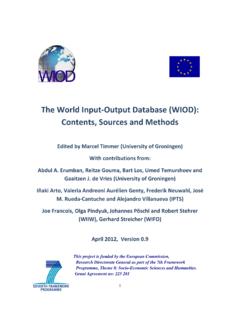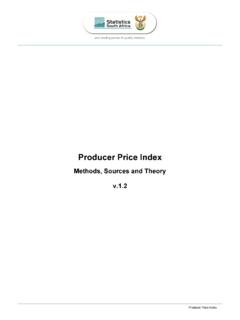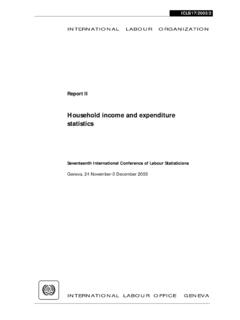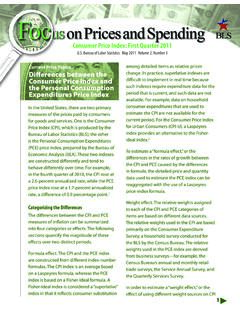Transcription of WIOD Socio‐Economic Accounts 2016
1 1 wiod socio economic Accounts 2016 Sources and methods REITZE GOUMA WEN CHEN PIETER WOLTJER MARCEL TIMMER JANUARY 2018 2 1. Introduction This document describes the sources and methods used for estimation of data on capital stocks and employment variables for the 43 countries included in the wiod 2016 database, called the socio - economic Accounts (SEAs). The SEAs contain annual data (2000-2014) for 56 industries on: Industry output, intermediate inputs, and value added Price deflators for the above mentioned variables Volume indices for the above mentioned variables Capital stocks in current prices Employment Compensation of capital and labour Note that this version of the wiod socio economic Accounts no longer provides information on the educational attainment of the labour force due to a lack of data, mostly for non-EU countries.
2 Table 1 below presents the full set of variables and their description, available in SEA 2016 . Table 1 Variables in the wiod socio - economic Accounts (SEA) Output Millions of national currency GO Gross output by industry at current basic prices II Intermediate inputs at current purchasers' prices VA Gross value added at current basic prices Labour input Employment units EMP Number of persons engaged (thousands) EMPE Number of employees (thousands) H_EMPE Total hours worked by employees (millions) Compensation Millions of national currency COMP Compensation of employees LAB Total labour compensation CAP Capital compensation Capital input Millions of national currency K Nominal capital stock Indices 2010 = 100 GO_PI Price levels of gross output II_PI Price levels of intermediate inputs VA_PI Price levels of gross value added GO_QI Gross output, volume indices II_QI Intermediate inputs, volume indices VA_QI Gross value added, volume indices In this document the sources and methods for the construction are discussed for each group of variables, excluding the output variables.
3 Detailed information for the first group, the nominal values of Gross Output, 3 Intermediate Inputs and Value Added, is given in the documentation on the construction of the World Input Output Tables (WIOTs) 20161. Section 2 continues the discussion of the construction of the Labour Input and compensation variables. In section 3 we turn to the construction methods of the capital stocks and in section 4 we discuss the sources for the price indices from which the volume indices are derived. Section 5 presents the frequently used mapping table between the ISIC Revision 3 industries from the SEA 2013 and the ISIC Revision 4 industries from the SEA 2016 . 2. Compensation and Labour Input This section discusses the sources and methods for both the estimation of the labour and capital compensation variables as well as labour input, since for many countries the calculation of total labour compensation (LAB) is based on the employment data.
4 First we start with a general discussion of the sources and methods for European Countries, then we conclude with the country specific information for the Non-EU countries. construction methods for EU28 countries and Norway The source for the compensation and employment data is Eurostat. We take the variables from the ESA 2010 National Accounts for detailed industries (nama_10_a64 and nama_10_a64_e).2 We use the same vintage as that used for the construction of the 2016 wiod . To ensure that output and employment figures are fully consistent, we use a stepwise approach to the construction of the compensation and employment data. For example, to estimate total employment (EMP) we do not rely on the employment figures listed in Eurostat directly, but instead estimate the ratio of VA to EMP from Eurostat and multiply by VA taken from the 2016 wiod .
5 Note that this method will leave the levels of the variables listed in Eurostat unaffected, unless in the construction of the (international) SUTs minor adjustments have been introduced (see the wiod 2016 documentation). In this approach, the order in which the variables are estimated could matter. First, we estimate total employment (EMP) based on the ratio of EMP to VA, as discussed above. Second, we multiply this newly obtained value for EMP with the ratio of employees to total employment from Eurostat to obtain the number of employees (EMPE) consistent with our output data. Third, we estimate the total hours worked by employees (H_EMPE) based on the average annual hours of work for employees derived from Eurostat.
6 Lastly, we estimate the total compensation of employees (COMP) based on the ratio of COMP to VA listed in Eurostat. Extrapolation and disaggregation If no (disaggregate) industry data is in available in Eurostat (nama_10_a64 and nama_10_a64_e) we rely on the total economy figures from Eurostat instead (nama_10_lp_ulc and nama_10_gdp). We disaggregate 1 Sources and methods for the wiod 2016 SUT input files can be found in Timmer, M. P., Los, B., Stehrer, R. and de Vries, G. J. ( 2016 ), "An Anatomy of the Global Trade Slowdown based on the wiod 2016 Release", GGDC research memorandum number 162, University of Groningen 2 Accessed: 15 January 2016 4 these figures, as well as the industry detail that is missing from the basic Eurostat tables to completely fill the cells for all years and industries in the SEA.
7 In the disaggregation we estimate the missing values based on the parent s value, the first available industry, one level of aggregation above the current industry. For example, in the estimation of total hours worked by employees (H_EMPE), we assume the average hours of work in the parent industry is representative for the average hours of work in the industry for which data is missing. If data for a given industry is unavailable for all years in the sample we directly rely on the level of the parent s average hours of work. If data is missing only for some years, we rely on the growth rate of the average hours of work for the parent instead and link this to the level of the average hours of work that is available for this industry.
8 We then normalize to ensure that total hours of work for the industry and its siblings sum to the total hours of work for the parent. We apply this procedure top-down, starting at the total economy level and working our way down to fill the industries at the lowest level of aggregation in the SEA. In our workflow, we first estimate the ratios discussed in the previous section for the industries and years for which data is available in Eurostat. We then extrapolate these ratios over time, whenever necessary, based on the total economy data from Eurostat. Lastly, we fill the missing values using the disaggregation procedure discussed in the previous paragraph. The full matrix of ratios, say EMP/VA, can then be used to calculate EMP for all years and industries by multiplying them with VA in the SEA.
9 Exceptions In some (exceptional) cases we opted to discard the Eurostat data for specific industries if the resulting ratios looked highly improbable. These exceptions are most likely the result of measurement issues, as it concerns almost exclusively minor industries for smaller economies. For these observations we based the ratios on the parent s ratio instead (see previous section). In practice, we only applied this procedure for the estimation of H_EMPE and only for four countries. For Finland we discarded the average hours of work data listed in Eurostat for all years for the industry codes A01, A02, and A03. For Cyprus and Malta, we discarded the average hours of work data for all the lowest aggregates for all For Latvia we discarded all the average hours of work data below the total economy level prior to 2008, to compensate for a clear break - most likely the result of a change in the SNA - that occurs in the Latvian data between the years 2007 and 2008.
10 In addition, we identified some outliers in the Eurostat data which we dropped from the SEA and interpolated 3 industry codes A01, A02, A03, C16, C17, C18, C19, C22, C23, C24, C25, C29, C30, C31_C32, C33, E36, E37-E39, G45, G46, G47, H49, H50, H51, H52, H53, J58, J59_J60, K64, K65, K66, L68A, L68x, M69_M70, M71, M73, M74_M75, N77, N78, N79, N80-N82, Q86, Q87_Q88, R90-R92, R93, S94, S95, S96 4 We identified observations as outliers if the ratio has a z-score below or above , but only if this was the case both across years (holding the industry constant) and industries (holding the year constant) for any given country. For the EMP/VA ratio we identified 0 outliers, for the EMPE/EMP ratio we identified 11 outliers ( of the sample), for the H_EMPE/EMPE ratio we identified 66 outliers ( of the sample, and for the COMP/VA ratio we identified 0 outliers.)






